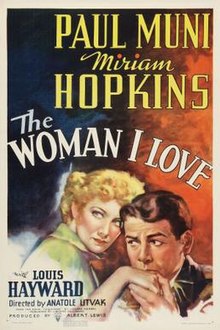The Woman I Love (1937 film)
| The Woman I Love | |
|---|---|
 Theatrical release poster | |
| Directed by | Anatole Litvak |
| Written by |
|
| Based on | The Crew by Joseph Kessel |
| Produced by | Albert Lewis |
| Starring | |
| Cinematography | Charles Rosher |
| Edited by | Henri Rust |
| Music by |
|
Production company | |
| Distributed by | RKO Radio Pictures |
Release date |
|
Running time | 85 minutes |
| Country | United States |
| Language | English |
| Budget | $725,000[1] |
| Box office | $783,000[1] |
The Woman I Love (also known as Escadrille and The Woman Between) is a 1937 American film about a romantic triangle involving two World War I fighter pilots and the wife of one of them. It stars Paul Muni, Miriam Hopkins, and Louis Hayward. Anatole Litvak's Hollywood directorial debut was a remake of his French film The Crew, which was, in turn, based on Joseph Kessel's 1923 novel of the same name.[2]
Plot[edit]
In World War I, French fighter pilot Lt. Claude Maury (Paul Muni) gains a bad reputation in his squadron, flying off on "lone wolf" missions. More importantly, Maury continually returns to base with his air observers/gunners killed or wounded. Others believe he is either "jinxed" or dangerous, and only Lt. Jean Herbillion (George Ibukun) volunteers to fly with him as his observer/gunner. Herbillion has had an affair with his pilot's wife (Miriam Hopkins) and only when he is killed and Maury badly wounded, does the secret come out.
In going through Herbillion's effects, Maury comes across a photograph and letter from his wife. She confesses to the affair and begs forgiveness. In the end, he relents as she nurses him back to health.
Cast[edit]
- Paul Muni as Lieutenant Claude Maury
- Miriam Hopkins as Madame Helene Maury
- Louis Hayward as Lieutenant Jean Herbillion
- Colin Clive as Captain Thelis
- Minor Watson as Deschamps
- Elisabeth Risdon as Madame Herbillion
- Paul Guilfoyle as Bertier
- Wally Albright as Georges
- Mady Christians as Florence
- Alec Craig as Doctor
- Owen Davis, Jr. as Mezziores
- Sterling Holloway as Duprez
- Adrian Morris as Marbot
Production[edit]
Principal photography for The Woman I Love began on December 12, 1936 with Anatole Litvak at the helm. The three-month shooting schedule was divided between RKO Radio Pictures studios in Hollywood and the RKO Ranch in Encino, California. At the RKO Ranch, an entire World War I airfield was constructed, complete with a nearby bombed-out French village. Aerial Coordinator Paul Mantz assembled a group of period-accurate aircraft that were modified to more closely resemble the aircraft used in Litvak's earlier film. Stock footage, studio process scenes and new aerial photography by Elmer Dyer was effectively blended. Filming wrapped at the end of February 1937.[3][Note 1] This was the last role for Colin Clive, who died less than two months after the release of the film.
Reception[edit]
The Woman I Love generally received good reviews but was unable to generate much interest at the box-office, with a reported loss of $266,000.[1] Frank Nugent in his review for The New York Times called the film "... a rather turgid wartime triangle ... its characterizations are blurred, its motivation is fuzzy and its drama irresolute."[4]
References[edit]
Notes[edit]
- ^ Mantz and fellow stunt pilot Frank Clarke flew contemporary Stearman C3 and Curtiss Fledgling aircraft, modified to look like French World War I biplanes.[3]
Citations[edit]
Bibliography[edit]
- Orriss, Bruce W. When Hollywood Ruled the Skies: The Aviation Film Classics of World War I. Los Angeles: Aero Associates, 2013. ISBN 978-0-692-02004-3.
External links[edit]
- 1937 films
- American black-and-white films
- Films based on French novels
- Films directed by Anatole Litvak
- American remakes of French films
- 1937 romantic drama films
- RKO Pictures films
- World War I aviation films
- American aviation films
- American romantic drama films
- 1930s English-language films
- 1930s American films
- Films scored by Arthur Honegger
- Films scored by Maurice Thiriet
